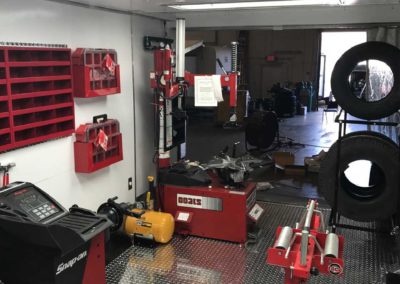Tire Solution: Proven Methods for Optimum Tire Upkeep and Care
Maintaining optimal tire condition is critical for both safety and security and efficiency of any lorry. From ensuring correct tire stress to normal turning and alignment, there are tried and tested techniques that can considerably expand the life-span of your tires and boost overall driving experience. As we explore the ins and outs of tire care and upkeep, we will certainly uncover important guidelines that every lorry proprietor ought to stick to for the ideal feasible results. Let's explore the world of tire solution and discover the keys to maintaining your tires in first-class shape for the long run.
Value of Tire Pressure
Correct tire pressure is a vital factor in making sure optimal car performance and safety and security on the roadway. Preserving the suggested tire pressure levels given by the maker uses numerous advantages. Adequate tire pressure promotes much better gas effectiveness, as under-inflated tires can lead to enhanced rolling resistance, creating the engine to function more difficult and take in more fuel. Second of all, correct tire pressure makes sure even tread wear, improving tire durability and saving cash in the future by delaying the need for early replacements. In addition, appropriately blew up tires add to improved handling and braking capacities, critical for secure driving in various road problems. Over-inflated tires, on the various other hand, can lead to minimized grip and a harsher adventure. Alternatively, under-inflated tires are vulnerable to getting too hot, which can lead to blowouts and accidents. Regularly changing and inspecting tire pressure, particularly soon journeys, is a basic yet reliable way to improve car efficiency, prolong tire life expectancy, and prioritize safety and security on the roadway.
Tire Turning Standards
When considering tire turning guidelines, it is essential to comprehend the significance of this maintenance job in taking full advantage of tire life-span and preserving ideal vehicle performance. Tire turning entails changing the position of each tire on a vehicle to make sure even tread wear. Front tires often tend to use more quickly than back tires due to steering pressures, making normal rotation vital for balanced wear patterns.

Advantages of Wheel Placement
Ensuring appropriate wheel alignment after tire turning is crucial for maintaining balanced wear patterns and taking full advantage of lorry performance. Additionally, proper wheel placement aids to extend the lifespan of your tires. Misaligned wheels can cause unequal tire wear, leading to premature tire replacement and enhanced upkeep prices.

Tire Footstep Depth Inspect
Doing a normal evaluation of tire tread depth is crucial for maintaining safe driving problems and lengthening the life expectancy of your tires. The step on your tires plays a critical duty in giving grip, especially in slippery or wet problems. To examine your tire walk deepness, you can use a tread depth gauge or the dime test. The suggested tread depth is at the very least 2/32 of an inch. If the walk depth is below this threshold, it is time to change your tires to ensure optimal efficiency and safety and security on the road. Unequal tread wear can suggest problems with tire alignment, stress, or suspension, highlighting the significance of regular step depth checks. Ignoring to check and preserve proper tread depth can cause lowered hold, longer stopping distances, and a boosted danger of hydroplaning. By integrating tire walk deepness checks into your routine maintenance schedule, you can drive with from this source confidence knowing that your tires are in leading condition.
Seasonal Tire Assessment
A thorough evaluation of tire problem tailored to specific climate condition is crucial for keeping optimal efficiency and safety and security throughout the year. Seasonal tire inspection is a fundamental aspect of tire maintenance that ensures tires prepare to deal with the difficulties positioned by various weather. In prep work for wintertime, it is necessary to examine the tire stress consistently as cool temperature levels can cause tire pressure to drop. Evaluating tire step depth is additionally vital to make sure sufficient traction on snow and ice-covered roads. In addition, checking for indications of wear and tear, such as lumps or fractures, can assist avoid prospective tire failures. As the seasons modification, it is essential to examine tire condition and make any kind of necessary modifications to ensure risk-free driving. By conducting regular seasonal tire evaluations, drivers can extend tire lifespan, boost fuel effectiveness, and most importantly, ensure a safe and secure driving experience in differing climate condition - Flat Tire Repair Las Vegas.
Final Thought
To conclude, maintaining correct website here tire pressure, turning tires consistently, lining up wheels properly, checking tread deepness, and performing seasonal evaluations are essential practices for optimal tire treatment. By following these shown methods, chauffeurs can ensure their tires last longer, execute far better, and add to overall automobile safety. It is essential to prioritize tire maintenance to avoid crashes, improve gas efficiency, and lengthen the life expectancy of tires.
Sufficient tire pressure advertises far better fuel effectiveness, as under-inflated tires can lead to raised rolling resistance, creating the engine to work tougher and consume even more gas.When taking into consideration tire anchor rotation guidelines, it is crucial to understand the significance of this upkeep task in making best use of tire life expectancy and maintaining ideal car efficiency. Seasonal tire inspection is an essential element of tire maintenance that makes sure tires are ready to encounter the challenges positioned by different weather condition problems. By conducting regular seasonal tire assessments, vehicle drivers can prolong tire lifespan, boost fuel efficiency, and most significantly, make certain a secure driving experience in differing climate conditions.
In conclusion, maintaining appropriate tire pressure, rotating tires routinely, lining up wheels properly, checking walk depth, and carrying out seasonal assessments are important methods for optimal tire treatment.